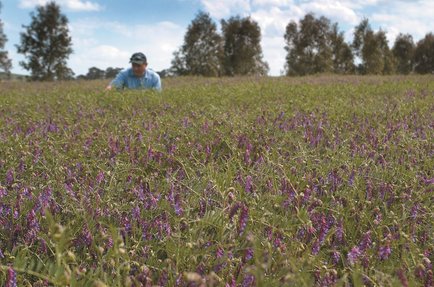Benefits of vetch in cropping rotations
 Vetch is a winter and spring sown annual legume that is commonly used as a disease break in cereal cropping rotations. A true multi-purpose crop, it offers high feed value and is ideal for hay production, early grazing as green pasture, dry grazing or green / brown manure.
Vetch is a winter and spring sown annual legume that is commonly used as a disease break in cereal cropping rotations. A true multi-purpose crop, it offers high feed value and is ideal for hay production, early grazing as green pasture, dry grazing or green / brown manure.
Vetch is often sown in combination with cereals for quality hay. It is also highly sought as fodder to support dairying due to excellent quality and palatability. Common vetch may also be used for grain.
Poor soils can be revived by vetch’s nitrogen rich organic matter boosting soil fertility, which helps to meet the needs of following crops.
Another benefit is that vetch after cereals can lower the ratio of carbon to nitrogen, improving soil health along with mineralisation and stubble decomposition.
In partnership with The South Australian Research Development Institute (SARDI), Barenbrug has been breeding vetch for a number of years, from which a collection of different varieties have been released including both common and woolly pod types.
Key releases are Morava and Rasina (common types) along with Capello and Haymaker (woolly pod). The primary objectives of the breeding program are to increase dry matter yield, create highly palatable and nutritious hay, be soft seeded and to build in disease resistance or tolerance to some of the more devastating diseases that attack vetch crops. These diseases include rust, acochyta blight, chocolate spot and botrytis grey mould. Rust is probably still the biggest threat on common types although newer cultivars are generally resistant.
One of the most recent releases, Volga has been bred as a high yielding grain/seed variety for low and mid rainfall areas. It is particularly suited to shorter season areas where the growing season finishes sharply. RM4 vetch has better early establishment than present woolly pod varieties. It is earlier in flowering and grain / seed maturity up to 10-15 days earlier than Haymaker or Capello.

